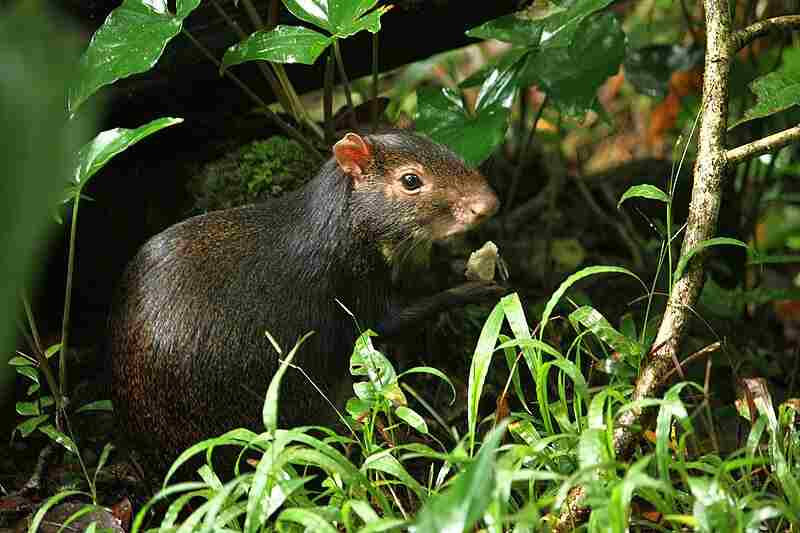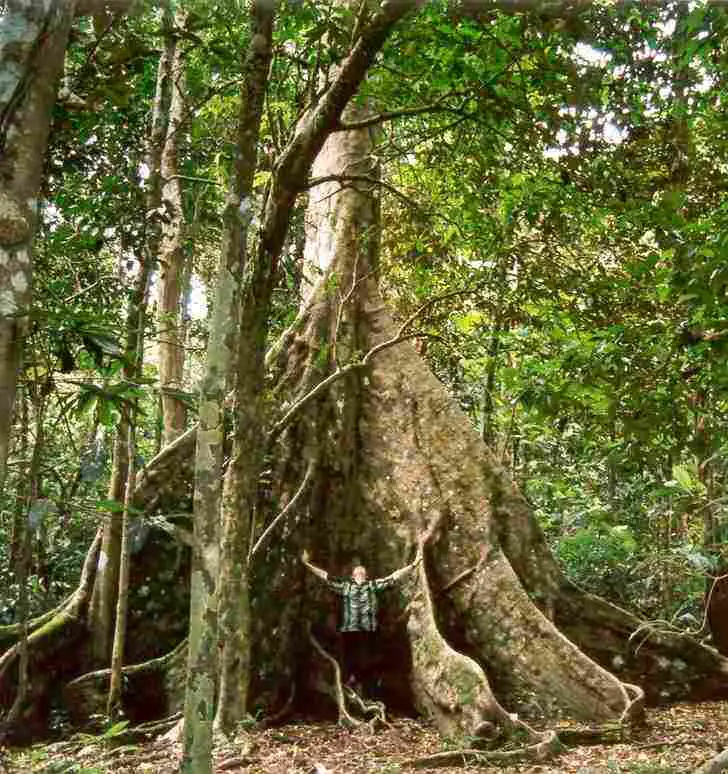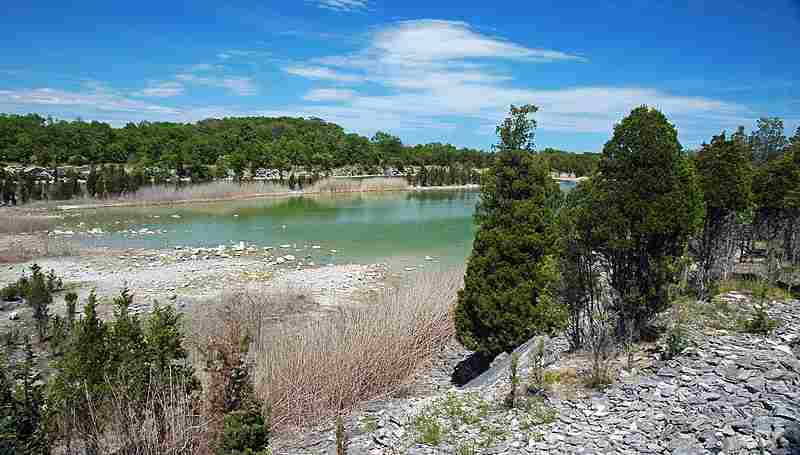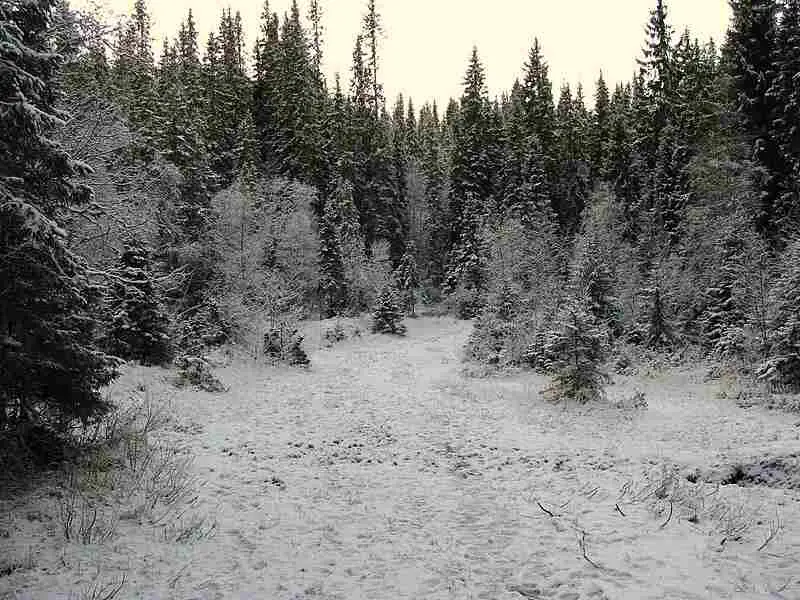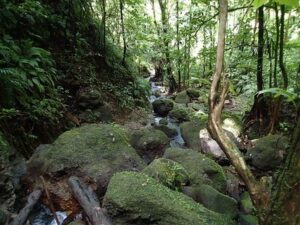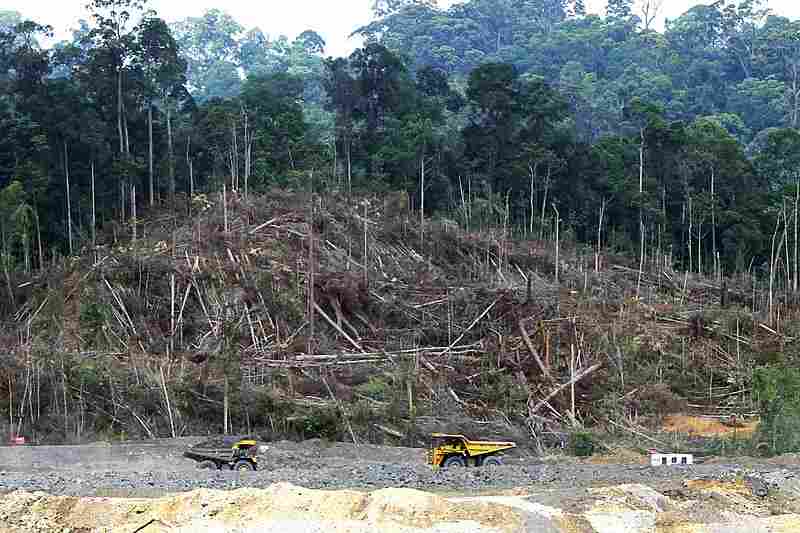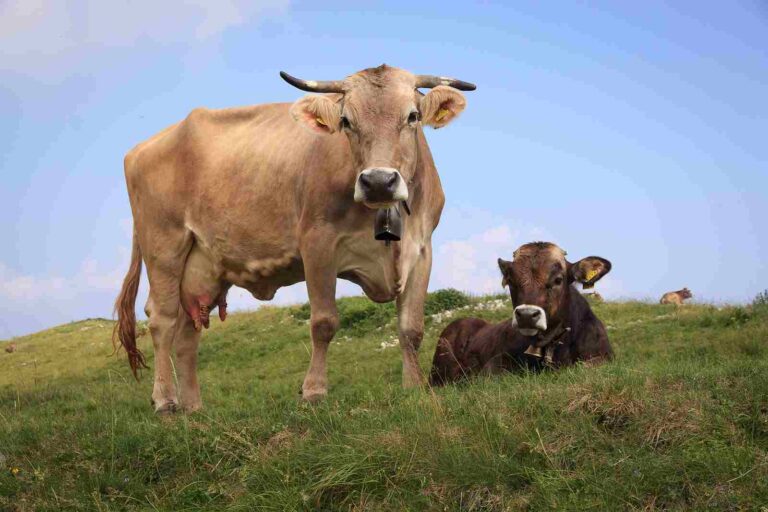9 Characteristics of Temperate Rainforest Ecosystems
Characteristics of temperate rainforest ecosystems are; mild temperatures, high average precipitation, high humidity, dense vegetation, annual seasonality, relatively high biodiversity, rich soil, wide geographic range, as well as the presence of broadleaf evergreens and coniferous podocarps.
This article discusses the characteristics of temperate rainforest ecosystems, as follows;
1). Mild Temperatures: One of the Characteristics of Temperate Rainforest Ecosystems
Mild temperatures are a typical characteristic of temperate rainforest ecosystems. These regions experience relatively moderate and cool temperature conditions throughout the year, which sets them apart from other terrestrial ecozones like tropical rainforests.
The mild temperature range in temperate rainforests is generally between 32°F and 68°F (0°C to 20°C), and contributes to the distinctive ecological dynamics, abiotic and biotic constitutions, of these ecosystems.
Relevance and Implications of Mild Temperatures in Temperate Rainforests
Moderate climate, year-round growing season, climate resilience, plant adaptations, animal adaptations, scientific research, tourism and recreation, educational value, and cultural significance, are all concepts that point to the relevance and implications of mild temperature, as an attribute of temperate rainforests.
The mild temperatures in temperate rainforests contribute to a stable and relatively moderate climate. This characteristic makes temperate ecosystems attractive for various species of plants and animals, as they do not have to contend with extreme temperature fluctuations as is the case with deserts and some tundras.
Absence of extremely cold temperatures implies that temperate rainforests have a longer growing season compared to more frigid ecoregions. This enables a diverse range of plant species to thrive, and contributes to the lush vegetation occurring within these ecosystems.
Mild temperatures may also enhance the resilience of temperate rainforests to climate-related disturbances. With relatively stable temperature conditions, these ecosystems can better cope with changing weather patterns, including extreme events.
Flora in temperate rainforests have evolved to thrive in mild conditions. Species have developed adaptive strategies to make the most of the available growing season and maintain their foliage throughout the year.
Animals that live in temperate rainforests have also adapted to the mild climate by developing strategies for foraging, breeding, as well as hibernation, that align with the available resources and conditions.
The study of temperate rainforests and their mild temperatures often provides insights into how climate influences the dynamics of ecosystems, and how these ecosystems may respond to global effects of climate change.
Mild temperatures also make temperate rainforests appealing for tourism and recreational activities. Visitors are drawn to these comfortable climates, which enhances eco-tourism opportunities.
The mild climate fosters year-round educational programs and activities, thereby promoting the awareness and understanding of these distinctive ecosystems.
Indigenous communities that live in regions with temperate rainforests have cultural and spiritual connections to the mild climates and the ecologic entities which they support. The mild temperature range distinguishes temperate rainforests from other biomes, contributing to their ecological and biological composition.
2). High Average Precipitation
Temperate rainforests are characterized by their high average precipitation, which makes them distinct from other temperate forest types.
While they generally receive less rainfall than tropical rainforests, the temperate rainforest still experiences significant moisture, ranging from 60 to 200 inches (150 to 500 cm) of precipitation on average, each year. This high level of rainfall, combined with coastal fog, establishes a consistently wet environment that has several implications for these ecosystems.
Relevance and Implications of High Precipitation in Temperate Rainforests
High precipitation has multiple implications for temperate rainforests, including; the creation of unique ecosystems, sustenance of biodiversity, support of freshwater ecosystems, carbon sequestration, environmental challenges and hazards, consistent moisture, influences on human settlement, and ecosystem services.
The high average precipitation is a defining feature of temperate rainforests and contributes significantly to their distinctive characteristics. These forests support a diverse range of temperate plant and animal species that are well-adapted to wet conditions.
Constant availability of moisture fosters high biodiversity. A variety of plant organisms, including towering evergreen trees and dense understory vegetation, thrive in this environment. This rich plant life, in turn, supports a broad array of animal species.
The abundant rainfall feeds freshwater ecosystems such as rivers, streams, lakes and wetlands. These aquatic ecosystems are essential for various species, including fish, invertebrates, and amphibians.

High precipitation contributes to the growth of dense vegetation in temperate rainforests. These forests serve as significant carbon sinks, capturing and storing atmospheric carbon dioxide, which helps to mitigate climate change.
While high precipitation is an essential abiotic factor for the health of temperate rainforests, it can also pose some challenges. Frequent and heavy rainfall can lead to environmental issues like soil erosion, landslides, and severe flooding, thereby potentially impacting both forest ecosystems and nearby communities.
The high levels of rainfall and coastal fog help provide consistent moisture throughout the year. This consistent moisture fosters the growth of plants and helps to maintain the lush, green appearance of temperate rainforests, even in seasons with less direct rainfall.
High average precipitation in regions surrounding temperate rainforests, often makes them challenging for human settlement and agriculture due to the wet conditions and risk of natural hazards associated with abundant rainfall.
The moisture provided by high precipitation contributes to vital ecosystem services such as water purification, climate regulation, air quality optimization, and the provision of natural resources like plant biomass, all of which benefit local communities and the broader environment.
3). High Humidity: One of the Characteristics of Temperate Rainforest Ecosystems
Temperate rainforests, with their coniferous or broadleaf vegetation, have the distinguishing feature of high humidity.
This elevated moisture content in the air is related to precipitation conditions, and has significant relevance and implications for both the functioning and ecological integrity of these ecosystems, as shown in the following discussion.
Relevance and Implications of High Humidity in Temperate Rainforests
Concepts and phenomena that highlight the relevance and implications of high humidity in temperate rainforests include; unique microclimate, support for moisture-dependent species, biodiversity hotspots, recycling of nutrients, temperature regulation, precipitation support, maintenance of ecosystem services, unique plant assemblages, and climate change mitigation.
High humidity creates a microclimate within temperate rainforests, that is characterized by moist, cool, and misty mornings and evenings. This unique atmospheric condition sustains the productivity and diversity of the forest.
Also, high humidity is an essential requirement, for a plethora of moisture-loving species, which include vascular and non vascular autotrophs like mosses, ferns, and epiphytic plants that thrive in temperate rainforests. These species contribute to the rich vegetation in the understory layer.
The combined effects of high humidity and abundant rainfall places temperate rainforests among the most biodiverse biomes on the planet. These conditions support the survival or a wide variety of plant and animal populations.
Humid conditions enhance biodegradation rates in the forest floor, which in turn enriches the soil with nutrients that are utilized by trees and understory plants. This nutrient cycling dynamic sustains the growth of vegetation.
High humidity in temperate rainforests also helps regulate temperature, and ensures that extreme fluctuations are mitigated. The humidity moderates both daytime heat and nighttime cold.
Heavy precipitation which temperate rainforests receive is complemented by high humidity, to create an environment that is conducive to the growth of tall, lush vegetation and to maintain optimal moisture levels.
Temperate rainforest humidity supports several, critical ecosystem services such as carbon sequestration, environment detoxification, and primary production.
The elevated humidity in temperate rainforests is favorable for the growth of low-lying autotrophic organisms, including bryophytes and lichens, some of which are rare or even unique to these ecosystems.
As implied earlier, high humidity contributes to the consistency of the temperate forest's climate. The rainforest typically experiences continuous high humidity, even in seasons with less direct precipitation.
Lastly, the persistence of high humidity can serve as a contributing factor in temperate rainforests' role as carbon sinks, by establishing microclimatic conditions that are instrumental in the global fight against climate change.
4). Dense Vegetation
Temperate rainforests are distinguished by their dense vegetation, which is characterized by towering trees, a diverse understory, as well as an abundance of epiphytic plants. This characteristic is both instrumental and critical in the functioning and ecological significance of these ecosystems.
Relevance and Implications of Dense Vegetation in Temperate Rainforests
Some factors and concepts pointing to the significance and implications of dense vegetation in temperate rainforests are; biodiversity sustenance, habitat diversity, protection against erosion, carbon sequestration, moisture retention, enhanced nutrient cycling, support for epiphytic plants, wildlife habitat creation, regulation of microclimate, ecosystem services. aesthetic and cultural value.
The dense vegetation in temperate rainforests fortifies the foundation of the food chain, and supports a broad range of plant and animal organisms. This high species richness/biodiversity is vital for the long-term continuity and resilience of the ecosystem.
Relatively thick vegetation creates a variety of viable microhabitats within the forest. This diversity of niches in turn provides opportunities for numerous species to find suitable conditions for foraging, breeding, and sheltering.
The dense network of roots and foliage produced by vegetation, helps bind soil, thereby preventing severe soil erosion. This is particularly important in areas with heavy rainfall, where erosion can be a significant challenge.
Dense vegetation, especially large trees, plays an effective role in the capture and storage of carbon dioxide, aiding in climate change mitigation by functioning as a carbon sink.
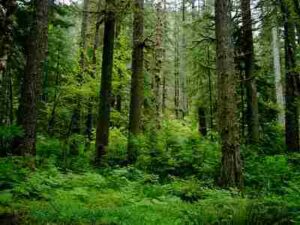
Both the canopy and understory of temperate rainforests act as natural sponges, which trap moisture from frequent rainfall and mist. This mechanism helps to maintain high humidity levels while preventing rapid drying of the forest floor.
The lush vegetation also supports a high rate of effective nutrient cycling. Leaves, branches, and other organic matter fall to the forest floor, where they decompose and enrich the soil with essential nutrients.
Both the thick canopy and humid environment in temperate rainforests, work together to provide an ideal habitat for epiphytic autotrophs, including mosses, ferns, and lichens, which grow on trees and add to the overall temperate biodiversity.
As earlier mentioned, the dense vegetation offers multiple niches for wildlife species. It provides hiding places, nesting sites, as well as foraging grounds for a wide range of animals, from birds and mammals to insects, reptiles and amphibians.
Dense vegetation influences the microclimate within the forest, by providing shade and minimizing rapid or extreme temperature fluctuations. This function helps to moderate both extreme heat during the day and frigid conditions at night.
The lush vegetation growing in temperate rainforests is instrumental for the provision of various ecosystem services such as; air pollution-mitigation, natural water filtration, nutrient cycling, and the production of resources such as timber, food, and medicinal plants.
Lastly, the dense, verdant landscapes of temperate rainforests are aesthetically valuable and have cultural importance to several indigenous communities and society as a whole.
5). Annual Seasonality: One of the Characteristics of Temperate Rainforest Ecosystems
Temperate rainforests exhibit a unique attribute – annual seasonality. This implies that, unlike tropical rainforests where climate remains relatively consistent throughout the year, temperate rainforests experience distinguishable seasons with variations in temperature and precipitation. The presence of seasonal change in these ecosystems has notable relevance and implications for their functioning and ecological sustainability.
Relevance and Implications of Annual Seasonality in Temperate Rainforests
Factors which can be used to understand the relevance and implications of annual seasonality in temperate rainforests, include; biodiversity and adaptations, plant phenology, wildlife migration, reproduction and breeding, fire regimes, plant growth and nutrient cycling, human activities, ecosystem resilience, and scientific research.
Seasonal variation in temperature and precipitation in temperate rainforests, generally results in the creation of a variety of ecological niches. This form of diversity supports a broad array of species many of which have evolved specific adaptations to enable them thrive in this environment. Some species, such as deciduous trees, undergo physiological changes in response to such seasonal shifts.
The phenology of plants is affected by seasonality, which influences their growth, flowering, and fruiting patterns. This, in turn, impacts the availability of essential resources for herbivores and other consumers that depend on vegetation for sustenance.
Some animals that live in temperate rainforests, exhibit seasonal migration patterns. For example, certain bird species may move to temperate rainforests during their breeding season and return to other regions during the winter.
Seasonality is a critical factor in the reproductive strategies of many temperate rainforest species. Breeding and nesting tend to occur during specific seasons when conditions are most favorable for the survival of offspring.
Also, seasonal variation can influence the fire regimes that occur in temperate rainforests. Some species rely on periodic fires in order to reproduce, while others possess effective strategies for survival and regenerative growth after fires.
Seasonal fluctuations in temperature and precipitation can influence the rate of plant growth and the decomposition of organic matter. These factors affect nutrient cycling trends in the ecosystem.
The presence of seasonal changes can also impact human activities within temperate rainforests, such as logging and tourism, which may be limited or regulated during certain seasons to protect the ecosystem.
Seasonal variability can boost the resilience of temperate rainforest ecosystems, in some cases. It may provide a degree of natural stability against extreme conditions and allow for effective recovery and adaptation following disturbances.
The seasonal patterns influence the provision of various ecosystem services, such as water purification, primary production, and pollination.
Understanding the annual seasonality in temperate rainforests is a vital requirement for ecological research and conservation schemes. Researchers study these ecosystems in order to learn about the intricate relationships that exist between species and how they adapt to changing conditions.
6). Relatively High Biodiversity
Temperate rainforests are also renowned for their relatively high biodiversity, which distinguishes them from other temperate ecosystems.
This characteristic refers to the diverse array of plant and animal species that can be found inhabiting these forests. The presence of high biodiversity in temperate rainforests has significant relevance and implications for the ecosystems and their conservation.
Relevance and Implications of Relatively High Biodiversity in Temperate Rainforests
Discussions regarding the relevance and implications of biodiversity in temperate rainforests may revolve around themes like; ecological niching, ecosystem resilience, species' interactions, nutrient cycling, phenological diversity, adaptive strategies; wildlife habitat, carbon sequestration, conservation significance, cultural significance; aesthetic and scientific value.
The complex structure and diverse microhabitats occurring in temperate rainforests, establish a range of ecological niches. This diversity of niches accommodates a highly diverse assemblage of, each of which is adapted to specific conditions within the forest.
High biodiversity enhances the resilience of temperate rainforest ecosystems. With numerous species carrying out different functions in the ecosystem, the system is well equipped to withstand disturbances and to recover from them.
Biodiversity fosters intricate species interactions. Predation, competition, mutualism, and other ecological relationships, are generally more complex in ecosystems with a greater variety of species, and may contribute to the overall wellbeing of the ecosystem.
Different plant and animal species contribute to nutrient cycling in diverse ways. Decomposition and nutrient turnover are more efficient in biodiverse ecosystems, and enhance soil fertility.
Biodiversity is directly linked to phenological diversity, meaning different species flower, fruit, and reproduce at various times throughout the year. This temporal diversity ensures a continuous food supply for foliar-herbivores and pollinators.
Species in temperate rainforests often exhibit a range of adaptive strategies which they use to cope with seasonal variations. Some are deciduous, shedding leaves in winter, while others have effective water conservation mechanisms that enable them stay evergreen, ensuring the forest remains green year-round.
The diverse vegetation and microhabitats in temperate rainforests; offer abundant shelter, breeding sites, and foraging grounds for a multitude of wildlife species, which include birds, mammals, insects, reptiles, and amphibians.
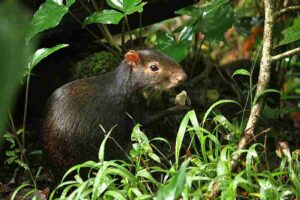
Growth of a broad range of plant species, especially large trees, in temperate rainforests contributes to the sequestration of carbon. These plants function as carbon sinks, helping to mitigate unfavorable climatic shifts.
The high biodiversity in temperate rainforests also makes them conservation hotspots. Protecting these ecosystems is very important in order to safeguard the many species that take refuge within them.
Presence of diverse plant and animal species is an enhancing factor to the aesthetic appeal of temperate rainforests. These organisms are also valuable for scientific research, as they provide insights into ecological relationships and adaptation strategies.
Indigenous communities and local cultures often have deep connections to the diverse species that are found in temperate rainforests. This biodiversity is a core aspect of their cultural heritage.
7). Rich Soil: One of the Characteristics of Temperate Rainforest Ecosystems
Temperate rainforests are known for their remarkably rich and fertile soils, which can be viewed as a defining attribute of these ecosystems.
The presence of rich soil has profound relevance and implications for the functioning, productivity, resilience and ecological significance of temperate rainforests.
Relevance and Implications of Rich Soil in Temperate Rainforests
Rich soil is a relevant abiotic component of temperate rainforests; for several reasons that can be summarized into themes like; support for lush vegetation, high primary productivity, carbon sequestration, nutrient cycling, support for epiphytes, habitat for mycorrhizal fungi, moisture retention, economic value, scientific research, and conservation significance.
The fertile soil found in temperate rainforests, provides essential nutrients which are supportive of the growth of a diverse group of plant species, including deciduous trees, evergreen vegetation, and non vascular bryophytes. This contributes to the lush and dense vegetation that characterizes these ecosystems.
Nutrient-rich soil enhances primary productivity, which is behind the rapid growth of plants. This productivity supports a thriving ecosystem, and sustains a wide range of animal species that rely on vegetation for their food and shelter.
The rapid growth of vegetation that is facilitated by rich soil, aids in carbon sequestration. As stated already before, these ecosystems act as significant carbon sinks, by capturing and storing atmospheric carbon dioxide, which can help mitigate some environmental problems.
Rich soil fosters efficient cycling of nutrients within the ecosystem. The decomposition of organic matter and recycling of nutrients both enrich the soil, and ensure that nutrients are readily available for plant growth.
Epiphytic plants, including bryophytes, thrive on the trees and branches of temperate rainforests. The availability of nutrients in the soil and humid conditions provide an ideal environment for sustaining these species.
Rich soil is also conducive to the growth of mycorrhizal fungi, which form mutually beneficial relationships with many plant species. These fungi aid in the uptake of nutrients by plants and contribute to ecosystem wellbeing.
The ability of soil to hold moisture is an important metric for the continuous availability of water to plant roots. This feature contributes to the overall humidity and high moisture levels in the biome.
Fertility of temperate rainforest soil supports its ecosystem services, including microclimate regulation, timber production, and water purification. The rich soil in temperate rainforests makes these areas valuable for both agriculture and timber production. However, it is important to balance economic activities with conservative measures to protect the natural resources of the ecosystem.
Distinctive characteristics of the soil in temperate rainforests are of interest to scientists studying nutrient cycling, plant-soil interactions, and the factors that contribute to high biodiversity.
The conservation of temperate rainforests and their rich soils is important to safeguard the ecological integrity of these ecosystems as well as protect the numerous plant and animal species that rely on them.
8). Wide Geographic Range
Temperate rainforests are characterized by a relatively wide geographic distribution, and occur in various regions across the world. This attribute of a broad geographic range has notable areas of relevance and implications for the ecosystems and the Earth as a whole. Some of such areas are addressed here.
Relevance and Implications of Wide Geographic Range in Temperate Rainforests
Factors that shed light on the relevance and implications of a wide geographic range for temperate rainforests include; global distribution, climate variability, biodiversity, conservation significance, scientific research, cultural and indigenous significance, economic value, climate change mitigation, tourism and education, as well as collaborative conservation.
Temperate rainforests are not confined to a single geographical area but are found in different parts of the world.
They occur along the coastlines of North and South America, Europe, Asia, New Zealand, and Australia; while some ecozones in Africa also possess typical temperate rainforest characteristics. This distribution provides an opportunity for comparative studies and a more comprehensive understanding of the entire temperate biome.

The wide geographic range means that temperate rainforests are exposed to different climatic conditions, from the mild maritime climates of the Pacific Northwest to the colder and more continental climates in segments of Europe and Asia. This variability has led to multidimensional adaptations by the flora and fauna to suit local conditions.
Geographic range contributes to the high biodiversity that can be observed in temperate rainforests around the world. Different regions may support distinct plant and animal species, and this diversity is a major feature of these ecosystems.
The presence of temperate rainforests in various parts of the world further underscores their conservation significance. These ecosystems are valuable for preserving biodiversity, providing ecosystem services, and contributing to the regulation of global climate.
Like other characteristics, wide distribution enables scientists to conduct comparative studies, which can help to uncover common ecological principles as well as distinctive regional adaptations. Such research is important for understanding ecological processes and guiding conservation schemes.
Broad geographic range for temperate rainforests means they have cultural and spiritual significance for indigenous communities in multiple regions. These ecosystems hold cultural knowledge and values for several communities.
Also, wide geographic range makes temperate rainforests valuable for timber, agriculture, and tourism in various regions. Here, it is important yet tasking to balance economic endeavor with conservation practices.
The broad distribution of temperate rainforests contributes to their function as global carbon sinks. They capture and store notable amounts of atmospheric carbon dioxide, thereby contributing to the mitigation of global warming.
The geographic range of temperate rainforests means that they are accessible to people in different parts of the world. This allows for eco-tourism opportunities and educational programs in such areas.
Lastly, global presence of temperate rainforests encourages collaboration among nations and environmental organizations in a bid to protect and manage these vital habitats. This collaboration can lead to more effective conservation strategies.
9). Presence of Broadleaf Evergreens and Coniferous Podocarps: One of the Characteristics of Temperate Rainforest Ecosystems
Temperate rainforests are characterized by the coexistence of broadleaf evergreen trees and coniferous podocarps, which creates a diverse and unique forest composition. This distinctive characteristic is relevant to the structure, biodiversity, and ecological trends of temperate forests.
Relevance and Implications of Broadleaf Evergreens and Coniferous Podocarps in Temperate Rainforests
The relevance and implications of broadleaf evergreens and coniferous podocarps in temperate rainforests can be analyzed within various contexts, including; diverse habitat structure, high biodiversity, phenological diversity,
Presence of both broadleaf evergreens and coniferous podocarps contributes to a multi-layered forest structure possessing distinct canopy, understory, and ground cover. This diverse habitat structure provides niches for a broad range of species, thereby enhancing biodiversity.
The coexistence of these tree types supports a rich diversity of both plant and animal species. Different organisms utilize the various available plants for food, shelter, and nesting, leading to a complex temperate food web of trophic interactions.
Combination of broadleaf evergreens and podocarps in temperate rainforests; results in a variety of leafing and fruiting trends throughout the year. This phenological diversity ensures a constant food supply for herbivores and contributes to the overall vitality of the ecosystem.
Both broadleaf evergreens and coniferous podocarps serve as essential resources for temperate wildlife. Their leaves, fruits, and seeds are important food sources, which provide sustenance for a range of herbivores, including insects and mammals.
The coexistence of these tree types enhances the carbon sequestration capacity of temperate rainforests. Broadleaf evergreens and podocarps capture and store atmospheric carbon dioxide simultaneously in their respective ways.
Diverse forest composition improves ecosystem resilience and equilibrium. Different species may respond differently to disturbances, allowing for a more rapid recovery after hazardous events like stormwater inundation, or wildfires.
The presence of broadleaf evergreens and coniferous podocarps also fosters complex ecological interactions, such as competition, predation, mutualism, and parasitism. These interactions are vital instruments for ecosystem functionality.
Both types of trees hold cultural value, and provide traditional resources for various communities. They are utilized for purposes such as building materials, medicines, and ceremonial items.
Also, the coexistence of broadleaf evergreens and podocarps in temperate rainforests offers a unique opportunity for scientific research. Scientists study these plant groups and their coexistence in a bid to understand the ecological relationships between different tree types and their influence on local biodiversity.
Lastly, the combination of broadleaf evergreens and coniferous podocarps is a defining feature of temperate rainforests and highlights their conservation significance. Protecting these trees is a vital step toward preserving their entire habitat.
Conclusion
Characteristics of temperate rainforests are;
1. Mild Temperatures
2. High Average Precipitation
3. High Humidity
4. Dense Vegetation
5. Annual Seasonality
6. Relatively High Biodiversity
7. Rich Soil
8. Wide Geographic Range
9. Presence of Broadleaf Evergreens and Coniferous Podocarps
